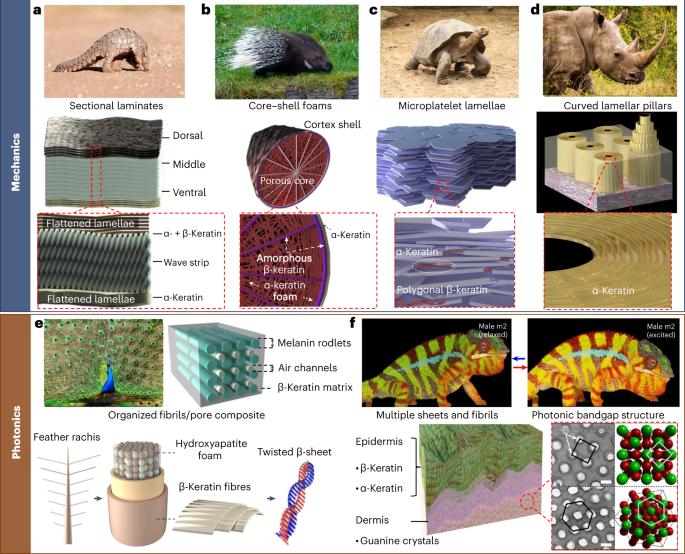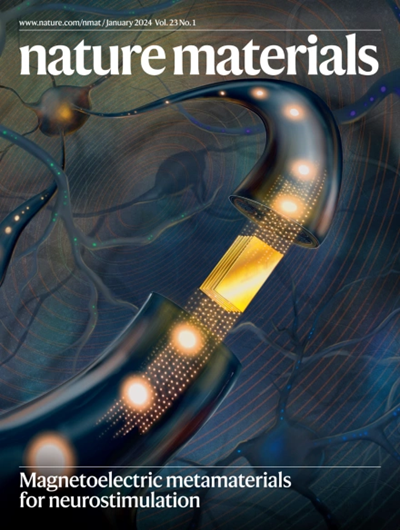Hierarchically structured bioinspired nanocomposites
IF 38.5
1区 材料科学
Q1 CHEMISTRY, PHYSICAL
引用次数: 59
Abstract
Next-generation structural materials are expected to be lightweight, high-strength and tough composites with embedded functionalities to sense, adapt, self-repair, morph and restore. This Review highlights recent developments and concepts in bioinspired nanocomposites, emphasizing tailoring of the architecture, interphases and confinement to achieve dynamic and synergetic responses. We highlight cornerstone examples from natural materials with unique mechanical property combinations based on relatively simple building blocks produced in aqueous environments under ambient conditions. A particular focus is on structural hierarchies across multiple length scales to achieve multifunctionality and robustness. We further discuss recent advances, trends and emerging opportunities for combining biological and synthetic components, state-of-the-art characterization and modelling approaches to assess the physical principles underlying nature-inspired design and mechanical responses at multiple length scales. These multidisciplinary approaches promote the synergetic enhancement of individual materials properties and an improved predictive and prescriptive design of the next era of structural materials at multilength scales for a wide range of applications. This Review discusses recent progress in bioinspired nanocomposite design, emphasizing the role of hierarchical structuring at distinct length scales to create multifunctional, lightweight and robust structural materials for diverse technological applications.

分层结构生物启发纳米复合材料
下一代结构材料有望成为轻质、高强度和坚韧的复合材料,并嵌入感知、适应、自我修复、变形和恢复等功能。本综述重点介绍生物启发纳米复合材料的最新发展和概念,强调通过调整结构、相间和限制来实现动态和协同响应。我们重点举例说明了天然材料的基石,这些材料具有独特的机械性能组合,其基础是在环境条件下的水环境中产生的相对简单的构建模块。我们特别关注跨越多个长度尺度的结构层次,以实现多功能性和稳健性。我们将进一步讨论结合生物和合成成分的最新进展、趋势和新兴机遇,以及最先进的表征和建模方法,以评估自然启发设计和多长度尺度机械响应的基本物理原理。这些多学科方法促进了单个材料特性的协同增强,并改进了下一代多长度尺度结构材料的预测性和规范性设计,适用于广泛的应用领域。本综述讨论了生物启发纳米复合材料设计的最新进展,强调了不同长度尺度的分层结构在创造多功能、轻质、坚固的结构材料以满足不同技术应用方面的作用。
本文章由计算机程序翻译,如有差异,请以英文原文为准。
求助全文
约1分钟内获得全文
求助全文
来源期刊

Nature Materials
工程技术-材料科学:综合
CiteScore
62.20
自引率
0.70%
发文量
221
审稿时长
3.2 months
期刊介绍:
Nature Materials is a monthly multi-disciplinary journal aimed at bringing together cutting-edge research across the entire spectrum of materials science and engineering. It covers all applied and fundamental aspects of the synthesis/processing, structure/composition, properties, and performance of materials. The journal recognizes that materials research has an increasing impact on classical disciplines such as physics, chemistry, and biology.
Additionally, Nature Materials provides a forum for the development of a common identity among materials scientists and encourages interdisciplinary collaboration. It takes an integrated and balanced approach to all areas of materials research, fostering the exchange of ideas between scientists involved in different disciplines.
Nature Materials is an invaluable resource for scientists in academia and industry who are active in discovering and developing materials and materials-related concepts. It offers engaging and informative papers of exceptional significance and quality, with the aim of influencing the development of society in the future.
 求助内容:
求助内容: 应助结果提醒方式:
应助结果提醒方式:


